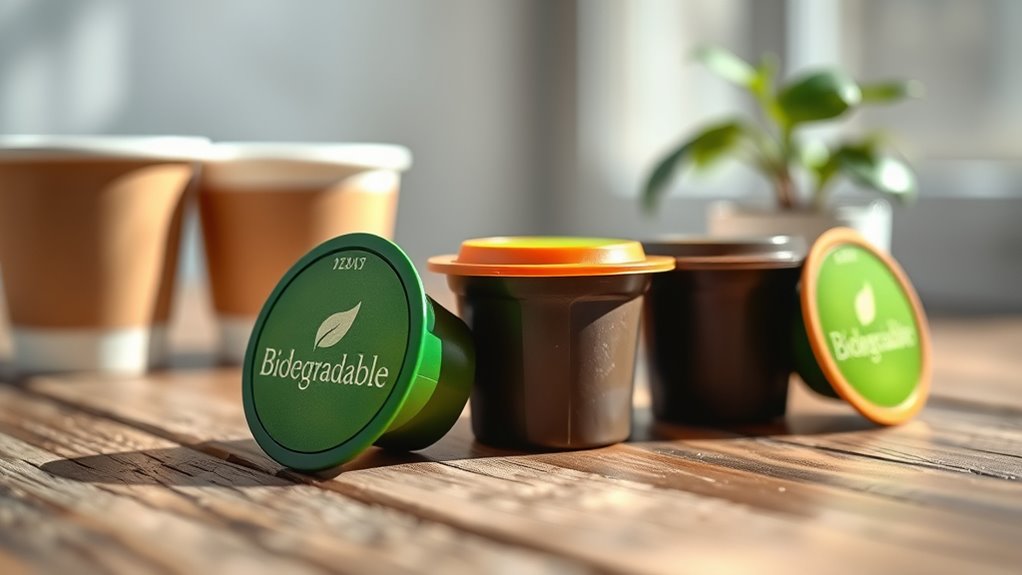To recognize greenwashing in “biodegradable” coffee pods, scrutinize product claims and look for trusted certifications with clear standards and third-party verification. Be wary of vague marketing phrases like “eco-friendly” or “sustainable,” and check what materials are used—preferably compostable or bioplastics. Also, pay attention to disposal instructions and whether the pods are tested for proper composting. If you want to spot real eco-friendly options, understanding these clues will help you make smarter choices.
Key Takeaways
- Verify if the product has credible, third-party eco certifications indicating genuine biodegradability and transparent standards.
- Be cautious of vague claims like “biodegradable” without specifying conditions, materials, or timeframes.
- Examine the pod’s materials—prefer compostable, plant-based plastics or paper over traditional plastics.
- Review disposal instructions to ensure proper composting methods and distinguish between industrial and home compostability.
- Watch for marketing language emphasizing eco-friendliness while ignoring manufacturing practices and full lifecycle impacts.
Understanding What “Biodegradable” Really Means
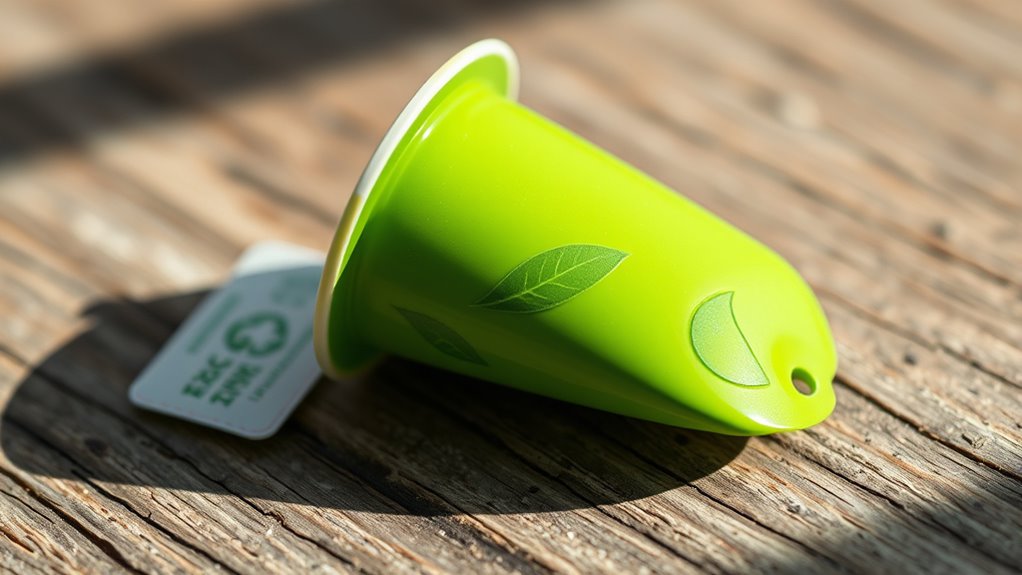
While the term “biodegradable” might suggest that a product will naturally break down without harming the environment, the reality is more complex. Biodegradable standards vary widely, and not all products labeled as such meet the same criteria. Some require specific conditions, like industrial composting facilities, to break down properly. You might assume that “biodegradable” means it’ll decompose easily in any environment, but composting challenges often hinder this process. For example, if the product isn’t designed to meet particular standards, it could persist in landfills or waterways, causing pollution. It’s important to understand that biodegradable doesn’t automatically equate to eco-friendly. Proper composting methods and adherence to standards are essential to truly minimize environmental impact. Additionally, UV exposure can influence how well biodegradable materials break down in natural settings.
Common Marketing Tactics That Mislead Consumers
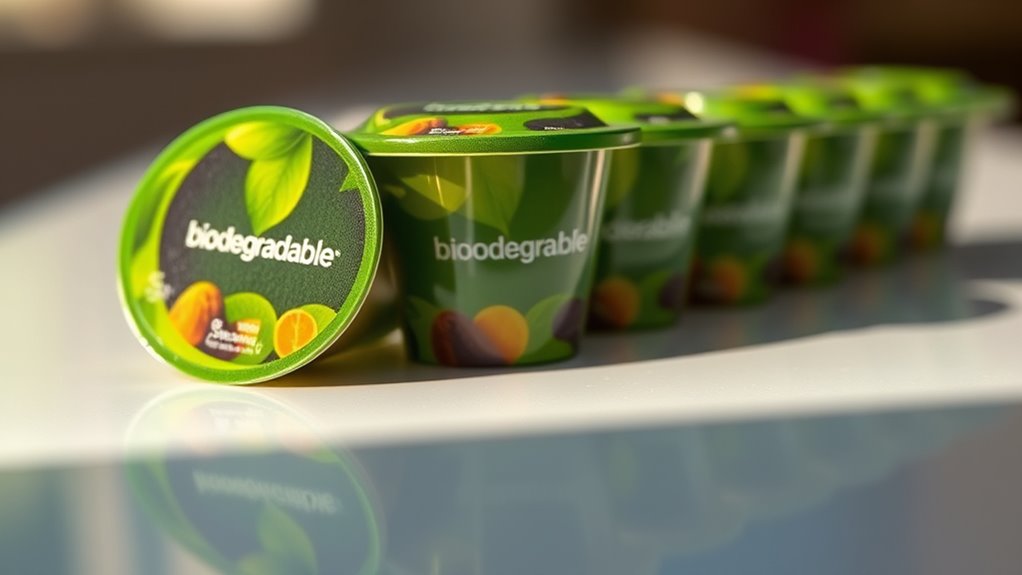
Many companies use clever marketing tactics to make biodegradable coffee pods seem more eco-friendly than they actually are. They rely on marketing jargon that sounds impressive but can be misleading, such as “green,” “sustainable,” or “eco-friendly,” without clear definitions. These phrases often create eco label myths, making consumers believe a product is environmentally superior when it might not be. Some brands highlight vague claims or use ambiguous language to distract from less eco-conscious practices. They might emphasize a small biodegradable component while ignoring the entire lifecycle or manufacturing impact. By understanding these tactics, you can better recognize when companies are overselling their environmental benefits and avoid falling for misleading claims that give a false impression of sustainability. Additionally, being aware of vertical storage solutions can help consumers organize their own spaces and make more eco-conscious choices in their daily lives.
The Role of Certifications and Labels in Eco-Claims
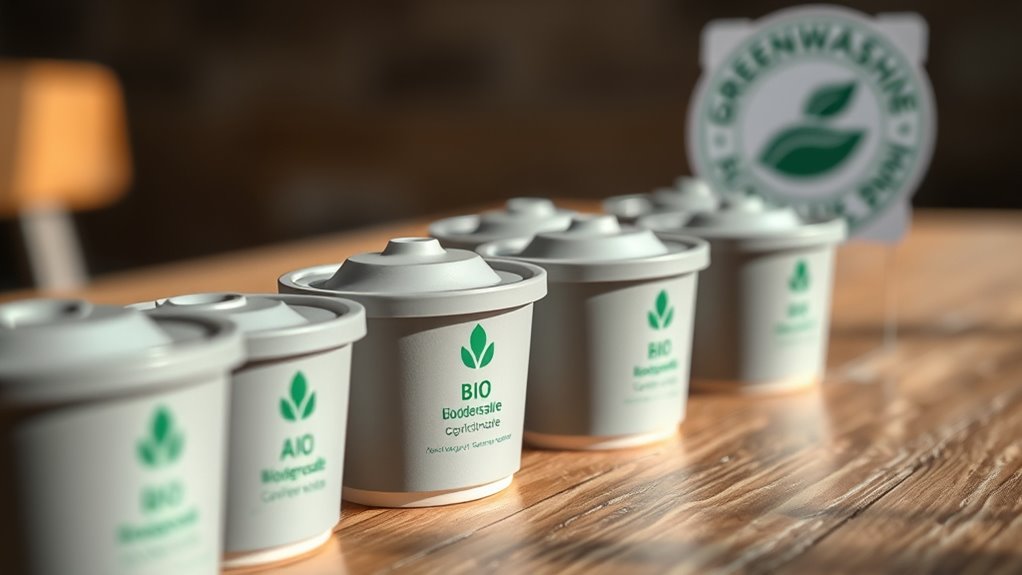
Certifications and labels play a crucial role in helping consumers identify genuinely eco-friendly products, but not all are equally trustworthy. You need to understand eco label credibility and certification standards to avoid being misled. Look for these signs:
Trust eco labels with clear standards, third-party verification, and transparency.
- Clear standards: Legitimate labels specify rigorous criteria that must be met.
- Third-party verification: Independent auditors ensure authenticity.
- Transparency: Detailed information about the certification process is accessible.
- Consistency: Labels align with recognized environmental principles.
- Alignment with industry standards: Certifications should be based on recognized home theatre projector principles to ensure reliability.
Analyzing the Composition of Coffee Pods

Understanding what coffee pods are made of is essential to evaluating their environmental impact. Start by examining the coffee packaging, which can vary widely in materials. Some pods claim to be biodegradable but use plastics that break down slowly or only under certain conditions. Look closely at the ingredients and materials listed; eco friendly materials like bioplastics, compostable plant-based plastics, or paper-based components are more sustainable options. Avoid pods made entirely of traditional plastics or those with mixed materials that hinder recycling or composting. The composition reveals whether the product truly supports environmental goals or merely uses greenwashing tactics. Additionally, the presence of Vetted materials, such as those confirmed to be biodegradable, is a strong indicator of genuine eco-friendliness. By analyzing the materials, you can determine if the pod’s claims of biodegradability are genuine or superficial, guiding you toward more eco-conscious choices.
The Importance of Disposal Instructions and Compostability
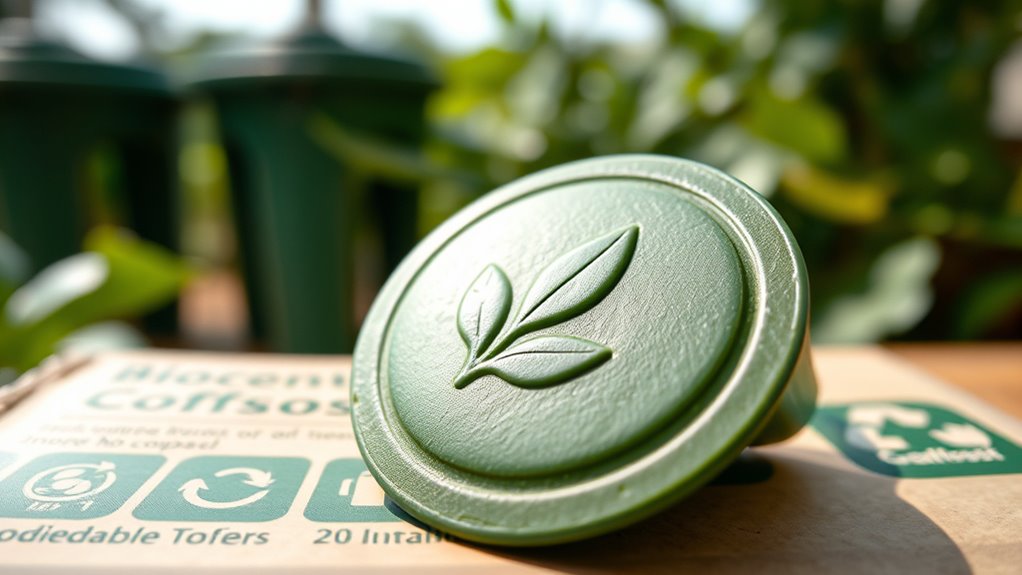
Clear disposal instructions are essential to guarantee that biodegradable coffee pods actually break down as claimed. Without proper disposal guidance, pods may end up in landfills, where composting challenges prevent decomposition. To avoid this, look for clear instructions on how to compost or dispose of the pods correctly. Consider these points:
- Are specific composting methods outlined?
- Is there guidance on whether the pod needs to be broken down before composting?
- Are local composting facilities capable of processing these pods?
- Does the packaging provide detailed disposal instructions to ensure proper breakdown?
- Understanding compostability standards can help determine if the product truly supports eco-friendly disposal.
These steps help you make environmentally responsible choices. Ignoring disposal guidance can undermine the eco-friendly promise and contribute to waste mismanagement. Properly understanding compostability and disposal ensures your actions truly support sustainability.
Recognizing the Limitations of Green Certifications
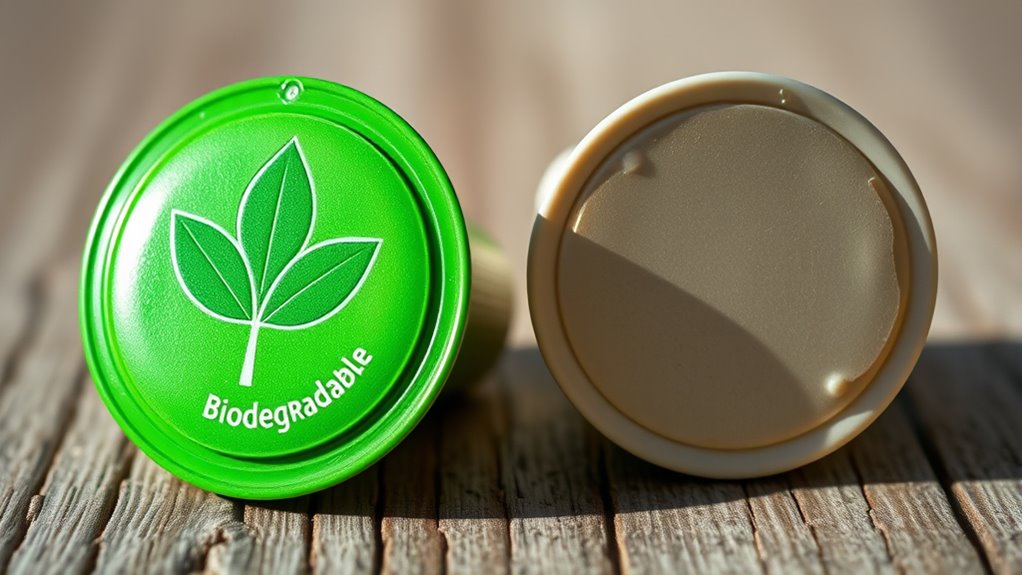
While green certifications can serve as helpful indicators of eco-friendly practices, they are not foolproof guarantees of sustainability. Certifications often focus on specific criteria, but they don’t always reflect a company’s overall corporate responsibility or environmental impact. Companies might pursue certifications to boost their image without making meaningful changes. As a consumer, your awareness of these limitations is essential. Don’t assume a product is entirely eco-friendly just because it bears a certification label. Some certifications are easier to obtain or may have loopholes. Recognizing these gaps helps you avoid greenwashing and makes you a more informed buyer. Additionally, understanding the scope of certifications can reveal their actual significance. Ultimately, understanding the scope and limitations of green certifications empowers you to evaluate a product’s true sustainability rather than relying solely on labels.
Tips for Choosing Truly Sustainable Coffee Options

To choose truly sustainable coffee options, you need to look beyond labels and marketing claims. Focus on transparency about coffee farm practices and certifications. Ask yourself:
- Are the farmers paid fair wages through fair trade certifications?
- Does the company support environmentally friendly farming methods?
- Are the coffee farm practices promoting biodiversity and soil health?
- Does the brand openly share details about their sourcing and sustainability efforts?
- Understanding zodiac compatibility can also help you align your values with brands that prioritize ethical relationships and community well-being.
Choosing coffee that champions ethical farm practices and holds certifications ensures your purchase supports fair treatment of workers and reduces environmental impact. Avoid greenwashing by doing your research and selecting brands committed to real sustainability. Your choices can make a difference, encouraging better practices across the coffee industry.
Frequently Asked Questions
How Can I Verify the Actual Environmental Impact of Biodegradable Coffee Pods?
To verify the environmental impact of biodegradable coffee pods, start by checking for certification standards like USDA Biobased or TÜV Austria. These indicate credible claims. Additionally, review lifecycle assessments from independent sources to see how the product performs from production to disposal. This helps you understand if the pods truly reduce environmental harm or if it’s just greenwashing. Always look for transparency and detailed environmental data.
Are There Specific Brands Known for Genuinely Sustainable Coffee Pods?
Is it a mirage or real oasis? You should seek brands with clear brand transparency and strong eco label credibility. Companies like Nespresso and TerraCycle have made strides, but always verify their claims. Look for third-party certifications and transparent sustainability reports, guiding you through the greenwashing fog. Doing so helps guarantee your coffee habit supports genuinely sustainable practices rather than misleading marketing illusions.
What Are the Environmental Consequences of Improper Disposal of Biodegradable Pods?
When you improperly dispose of biodegradable coffee pods, you contribute to plastic pollution and landfill accumulation. Although they’re labeled biodegradable, if they don’t break down properly, they can persist in the environment, harming wildlife and polluting waterways. This misuse undermines sustainability efforts, leading to increased waste and environmental damage. To reduce these impacts, always dispose of biodegradable pods according to local guidelines, ensuring they break down as intended.
How Do Local Waste Management Policies Affect Biodegradability Claims?
You should know that local waste management policies greatly influence biodegradability claims. Regulatory standards vary, so a pod labeled biodegradable might not break down properly if your area’s facilities don’t support composting or specific disposal methods. Consumer awareness plays a role too; understanding these policies helps you make informed choices and avoid greenwashing, ensuring the products you buy truly align with environmental sustainability goals.
Can Biodegradable Coffee Pods Be Composted at Home or Only Commercially?
Imagine it’s 1999, and recycling standards weren’t what they are today. Biodegradable coffee pods often can’t be composted at home because their material composition varies, requiring specific conditions. Many are designed for commercial composting facilities that meet strict standards. To guarantee proper disposal, check the packaging for composting guidelines, so you don’t accidentally contribute to waste. Home composting might not be effective unless the pods are explicitly labeled for it.
Conclusion
By staying informed, you can spot greenwashing like a detective uncovering clues. Just as a lighthouse guides ships safely through fog, understanding labels and disposal instructions helps you make truly sustainable choices. Don’t let slick marketing tricks lead you astray—your choices matter. When you choose genuinely eco-friendly coffee options, you’re steering towards a greener future, like a steady hand guiding a boat through calm waters. Keep questioning, keep choosing wisely.
